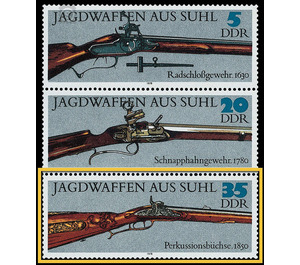Hunting weapons from Suhl - Germany / German Democratic Republic 1978 - 35 Pfennig
Theme: Devices, Items & Instruments
| Country | Germany / German Democratic Republic |
| Issue Date | 1978 |
| Face Value | 35.00 |
| Color | grey |
| Perforation | K 14 |
| Printing Type | Rotogravure 2 |
| Stamp Type | Postage stamp |
| Item Type | Stamp |
| Chronological Issue Number | 2122 |
| Chronological Chapter | GER-DDR |
| SID | 426615 |
| In 13 Wishlists | |
Suhl hunting guns With illustrations of Suhl hunting weapons, the Ministry of Posts and Telecommunications of the German Democratic Republic publishes six multi-colored special postage stamps in two se-tenant prints. The values of 5, 20 and 35 pfennigs as well as 10, 25 and 70 pfennig are printed together. Special cancellations from November 21, 1978 to January 20, 1979 Hunting weapons from Suhl The Waffenstadt Suhl on the southern slope of the Thuringian Forest can look back on a four-hundred-year tradition in the manufacture of small arms for military, hunting and sporting purposes. Today this traditional weapon production serves exclusively the noble activity of the Waidwerk and the peaceful competition of the sport shooters. The quality products of the Suhl gunsmiths, awarded with the highest quality mark of the GDR, with already 12 gold medals of the Leipzig Fair and a variety of gold, silver and bronze medals, which were won at Olympic Games, World and European Championships, are among the hunters and Protective shooters on all continents have become an indispensable possession. The hunting and sporting weapons program from Suhl is set far and includes double shotguns, Bockdoppelflinten, Bockbüchsflinten, Bockdoppelbüchsen, triplets, small caliber rifles, as well as air rifles and pistols. The historical rifles come from the collection of the Museum of Arms Suhl, which was opened on 5 May 1971 on the occasion of the European Championships in shooting. This special museum has the task of collecting and maintaining historical handguns as well as researching their history. The exhibition of the museum gives an overview of 500 years development of small arms and the history of the productive forces in this craft and industry branch. The collection items include rifles, handguns, and accessories for hunting, sporting, military, and civilian use from many countries around the world. 35-pfennig value: percussion rifle, 1850 The percussion rifle comes from the final phase of the muzzle-loader production and is a hunting rifle richly decorated with various techniques. The octagonal tan barrel has fine silver wire tappings on the top and an inlaid sight with brass horn and fixed rear sight. The tail screw of the barrel is covered by a brass plate. Lock plate, lock counter plate and cock of the rifle are decorated by etching and pier engraving with hunting motifs and plant ornaments. The remaining fittings, such as trigger, piston plate, paster box lid and sleeves for the ramrod are executed in fire-gilded brass and richly decorated by relief engraving. The dark nut tree trunk bears dainty rococo ornaments in the bas-relief section. The weapon from the mid-19th century combines not only the various stylistic features but also the different ornamentation techniques of this time.


